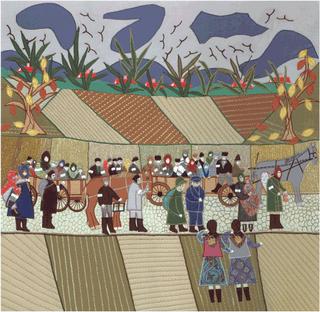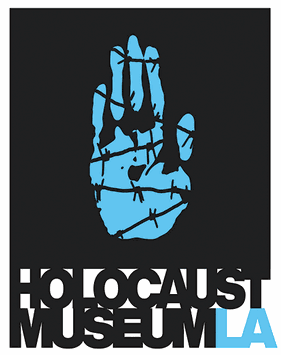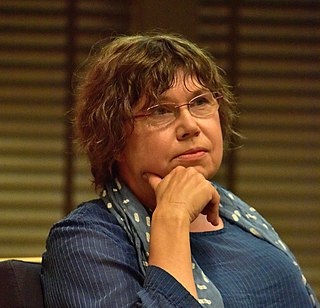
Jonas Mekas was a Lithuanian-American filmmaker, poet, and artist who has been called "the godfather of American avant-garde cinema". Mekas' work has been exhibited in museums and at festivals worldwide.

MS St. Louis was a diesel-powered passenger ship properly referred to with the prefix MS or MV, built by the Bremer Vulkan shipyards in Bremen for HAPAG, better known in English as the Hamburg America Line. The ship was named after the city of St. Louis, Missouri. Her sister ship, MS Milwaukee, was also a diesel powered motor vessel owned by the Hamburg America Line. St. Louis regularly sailed the trans-Atlantic route from Hamburg to Halifax, Nova Scotia, and New York City, and made cruises to the Canary Islands, Madeira, Spain; and Morocco. St. Louis was built for both transatlantic liner service and for leisure cruises.

This is a selected bibliography and other resources for The Holocaust, including prominent primary sources, historical studies, notable survivor accounts and autobiographies, as well as other documentation and further hypotheses.

The Museum of Tolerance-Beit HaShoah, a multimedia museum in Los Angeles, California, United States, is designed to examine racism and prejudice around the world with a strong focus on the history of the Holocaust. The museum was established in 1993, as the educational arm of human rights organization, the Simon Wiesenthal Center. The museum also deals with atrocities in Cambodia and Latin America, along with issues like bullying and hate crimes. The museum has an associated museum and professional development multi-media training facility in New York City.
The Holocaust has been a prominent subject of art and literature throughout the second half of the twentieth century. There is a wide range of ways–including dance, film, literature, music, and television–in which the Holocaust has been represented in the arts and popular culture.

America's Black Holocaust Museum (ABHM) is dedicated to the history of the Black Holocaust in America. The museum was founded in 1988 by James Cameron, who became well known after surviving a lynching.

Holocaust survivors are people who survived the Holocaust, defined as the persecution and attempted annihilation of the Jews by Nazi Germany and its allies before and during World War II in Europe and North Africa. There is no universally accepted definition of the term, and it has been applied variously to Jews who survived the war in German-occupied Europe or other Axis territories, as well as to those who fled to Allied and neutral countries before or during the war. In some cases, non-Jews who also experienced collective persecution under the Nazi regime are considered Holocaust survivors as well. The definition has evolved over time.

Felix Samoilovich Lembersky [1] was a Russian/Soviet painter, artist, teacher, theatre stage designer, and organizer of artistic groups.[1] He is known for his 'Execution. Babi Yar' series (1944–52), which are considered to be among the earliest artistic representations of the Nazi massacres of Jews in Kyiv.

Esther Nisenthal Krinitz was a Polish Jewish artist.

Holocaust Museum LA, formerly known as Los Angeles Museum of the Holocaust, is a museum located in Pan Pacific Park within the Fairfax district of Los Angeles, California. Founded in 1961 by Holocaust survivors, Holocaust Museum LA is the oldest museum of its kind in the United States. Its mission is to commemorate those murdered in the Holocaust, honor those who survived, educate about the Holocaust, and inspire a more dignified and humane world.

The Dallas Holocaust and Human Rights Museum is a history education museum in Dallas, Texas, in the West End Historic District at the southeast corner of N. Houston Street and Ross Avenue. Its mission is to teach the history of the Holocaust and advance human rights to combat prejudice, hatred, and indifference. It features climate-controlled archives and a research library to expand education.

Holocaust Memorial is a public artwork by American artist Claire Lieberman located on the Jewish Museum Milwaukee lawn, which is near downtown Milwaukee, Wisconsin, United States. It is located at 1360 North Prospect Ave. This piece is 10 ft x 24 ft x 20 ft. The materials used are Corten steel, black granite, and brick. The Holocaust Memorial was created in 1983.

Margarete Heymann, also known as Margarete Heymann-Löbenstein, Margarete Heymann-Marks, and Grete Marks, was a German ceramic artist of Jewish origin and a Bauhaus student. In 1923 she founded the Haël Workshops for Artistic Ceramics at Marwitz that she had to close in 1933 and settled in Jerusalem. She moved to Britain in 1936 and continued her work, becoming world famous as “Greta Pottery”. Her finest work is considered to be from her working period in Germany.

The Oregon Jewish Museum and Center for Holocaust Education is the largest museum dedicated to the documented and visual history of the Jews of Oregon, United States. The Museum is dedicated to the preservation, research, and exhibition of art, archival materials, and artifacts of the Jews and Judaism in Oregon.

Museum of the Holocaust – victims of fascism, Odesa – the first Museum in Ukraine, which is based on the events of the genocide of the Jewish population in Transnistria Governorate.

Barbara Engelking is a Polish psychologist and sociologist specializing in Holocaust studies. The founder and director of the Polish Center for Holocaust Research in Warsaw, she is the author or editor of several works on the Holocaust in Poland.
Jews who were married to non-Jews had a greater chance of surviving the Holocaust. In Germany, Jews in "privileged mixed marriages" were exempt from some anti-Jewish laws. All intermarried Jews in Greater Germany were generally exempted from deportation during the Holocaust until early 1945, which enabled 90 percent to survive. However, they faced strong pressure from Nazi authorities to divorce, which would end the protection for the Jewish partner. A famous event is the 1943 Rosenstrasse protest, in which non-Jewish women protested in Berlin after their Jewish husbands were arrested. It is unclear whether this action prevented the deportation of their husbands.

Many priceless artworks by the Dutch post-impressionist artist Vincent van Gogh were looted by Nazis during 1933–1945, mostly from Jewish collectors forced into exile or murdered.
















